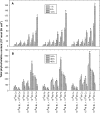Suppression of Chlorella vulgaris growth by cadmium, lead, and copper stress and its restoration by endogenous brassinolide
- PMID: 20523975
- PMCID: PMC3047691
- DOI: 10.1007/s00244-010-9551-0
Suppression of Chlorella vulgaris growth by cadmium, lead, and copper stress and its restoration by endogenous brassinolide
Abstract
Brassinosteroids play a significant role in the amelioration of various abiotic and biotic stresses. In order to elaborate their roles in plants subjected to heavy metals stress, Chlorella vulgaris cultures treated with 10(-8) M brassinolide (BL) were exposed to 10(-6)-10(-4) M heavy metals (cadmium, lead and copper) application. Under heavy metals stress, the growth and chemical composition (chlorophyll, monosaccharides, and protein content) have been decreased during the first 48 h of cultivation. The inhibitory effect of heavy metals on C. vulgaris cultures was arranged in the following order: copper > lead > cadmium. C. vulgaris cultures treated with BL in the absence or presence of heavy metals showed no differences in the endogenous level of BL. On the other hand, treatment with heavy metals results in BL level very similar to that of control cell cultures. These results suggest that the activation of brassinosteroids biosynthesis, via an increase of endogenous BL, is not essential for the growth and development of C. vulgaris cells in response to heavy metals stress. Simultaneously, BL enhanced the content of indole-3-acetic acid, zeatin, and abscisic acid in cultures treated with heavy metals. Levels per cell of chlorophylls, protein, and monosaccharides are all increased by BL treatment when compared to nontreated control cells. Application of BL to C. vulgaris cultures reduced the accumulation of heavy metals stress on growth, prevented chlorophyll, monosaccharides, and protein loss, and increased phytochelatins content. The arrested growth of C. vulgaris cells treated with heavy metals was restored by the coapplication of BL. It suggested that BL overcame the inhibitory effect of heavy metals. From these results, it can be concluded that BL plays the positive role in the alleviation of heavy metals stress.
© The Author(s) 2010. This article is published with open access at Springerlink.com
Figures






Similar articles
-
Phytohormones as regulators of heavy metal biosorption and toxicity in green alga Chlorella vulgaris (Chlorophyceae).Plant Physiol Biochem. 2012 Mar;52:52-65. doi: 10.1016/j.plaphy.2011.11.009. Epub 2011 Dec 1. Plant Physiol Biochem. 2012. PMID: 22305067
-
Brassinosteroid enhanced the level of abscisic acid in Chlorella vulgaris subjected to short-term heat stress.J Plant Physiol. 2009 May 15;166(8):882-6. doi: 10.1016/j.jplph.2008.10.004. Epub 2008 Dec 4. J Plant Physiol. 2009. PMID: 19062130
-
Synergistic effect of auxins and brassinosteroids on the growth and regulation of metabolite content in the green alga Chlorella vulgaris (Trebouxiophyceae).Plant Physiol Biochem. 2013 Oct;71:290-7. doi: 10.1016/j.plaphy.2013.08.003. Epub 2013 Aug 20. Plant Physiol Biochem. 2013. PMID: 23994360
-
Effects of brassinosteroids on the plant responses to environmental stresses.Plant Physiol Biochem. 2009 Jan;47(1):1-8. doi: 10.1016/j.plaphy.2008.10.002. Epub 2008 Oct 17. Plant Physiol Biochem. 2009. PMID: 19010688 Review.
-
Plant hormones: brassinosteroids in the spotlight.Curr Biol. 1996 Jun 1;6(6):658-61. doi: 10.1016/s0960-9822(09)00442-4. Curr Biol. 1996. PMID: 8793287 Review.
Cited by
-
PscCYP716A1-Mediated Brassinolide Biosynthesis Increases Cadmium Tolerance and Enrichment in Poplar.Front Plant Sci. 2022 Jul 5;13:919682. doi: 10.3389/fpls.2022.919682. eCollection 2022. Front Plant Sci. 2022. PMID: 35865284 Free PMC article.
-
Brassinosteroids: A Promising Option in Deciphering Remedial Strategies for Abiotic Stress Tolerance in Rice.Front Plant Sci. 2017 Dec 20;8:2151. doi: 10.3389/fpls.2017.02151. eCollection 2017. Front Plant Sci. 2017. PMID: 29326745 Free PMC article. Review.
-
Microalgal Metallothioneins and Phytochelatins and Their Potential Use in Bioremediation.Front Microbiol. 2020 Apr 28;11:517. doi: 10.3389/fmicb.2020.00517. eCollection 2020. Front Microbiol. 2020. PMID: 32431671 Free PMC article. Review.
-
Phytohormone up-regulates the biochemical constituent, exopolysaccharide and nitrogen metabolism in paddy-field cyanobacteria exposed to chromium stress.BMC Microbiol. 2020 Jul 13;20(1):206. doi: 10.1186/s12866-020-01799-3. BMC Microbiol. 2020. PMID: 32660415 Free PMC article.
-
Water and sediment quality assessment in the Colastiné-Corralito stream system (Santa Fe, Argentina): impact of industry and agriculture on aquatic ecosystems.Environ Sci Pollut Res Int. 2018 Mar;25(7):6951-6968. doi: 10.1007/s11356-017-0911-4. Epub 2017 Dec 22. Environ Sci Pollut Res Int. 2018. PMID: 29273985
References
-
- Atici Ö, Ağar G, Battal P. Changes in phytohormone contents in chickpea seeds germinating under lead or zinc stress. Biol Plant. 2005;49:215–222. doi: 10.1007/s10535-005-5222-9. - DOI
-
- Bajguz A. Blockade of heavy metals accumulation in Chlorella vulgaris cells by 24-epibrassinolide. Plant Physiol Biochem. 2000;38:797–801. doi: 10.1016/S0981-9428(00)01185-2. - DOI
-
- Bajguz A. Brassinosteroids and lead as stimulators of phytochelatins synthesis in Chlorella vulgaris. J Plant Physiol. 2002;159:321–324. doi: 10.1078/0176-1617-00654. - DOI
MeSH terms
Substances
LinkOut - more resources
Full Text Sources

